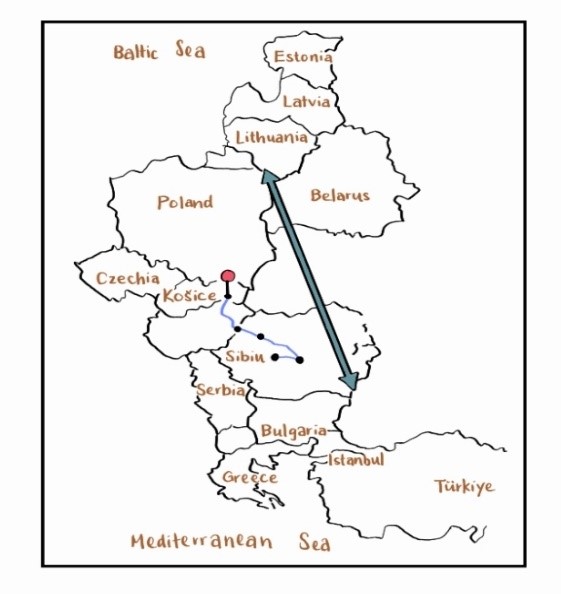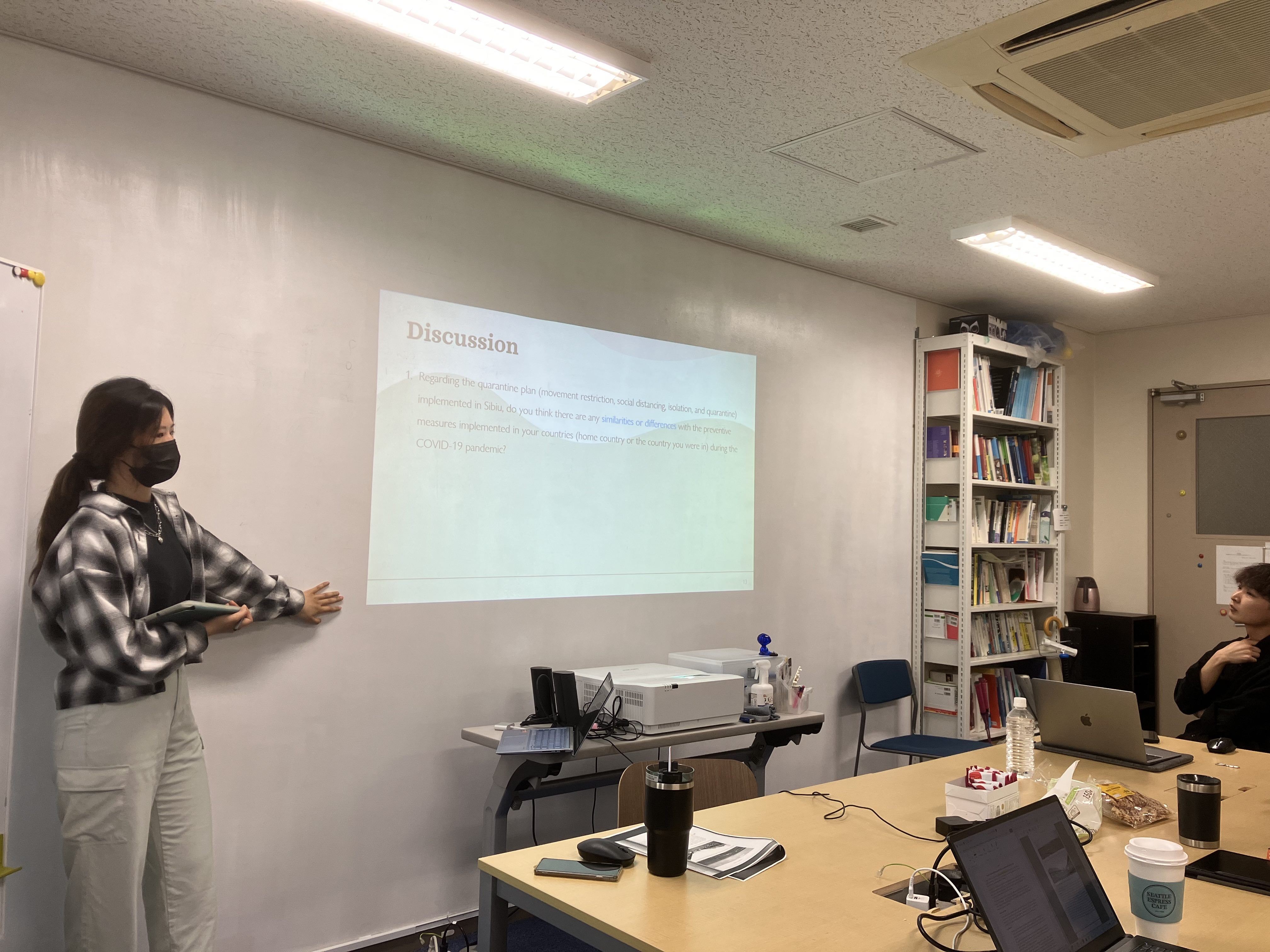Epidemic Urbanism: Contagious Diseases in Global Cities
Part I: Urban Governance: Politics and Management
Case studies presented:
- Plague in Sibiu and the First Quarantine Plan in Central Europe, 1510.
- Mughal Governance, Mobility, and Responses to the Plague in Agra, India.
- Colonialism, Racism, and the Government Response to Bubonic Plague in Nairobi, Kenya.
Date presented: 1st May 2023
Presenter: Chan Yu Nin
Case Study 1: Plague in Sibiu and the First Quarantine Plan in Central Europe, 1510.
Background
At the beginning of the 14th century, trades between the countries around the Mediterranean Sea and the Baltic Sea areas (blue and red shaded regions in Fig 1) were active. This led to an important stretch of trade route (marked blue line in Fig 1) across Hungary, facilitating the trade for silk and spices. While this route was important for business, it also accelerated the spread of diseases.
Fig 1 Active trade route in Central Europe in the 14th century
Outbreak of Plague
In 1510, a severe outbreak of plague spread across from Hungary to the cities on the trade route. During this time of crisis, there was a physician at Sibiu (located in Transylvania, now Romania) named Johannes Saltzman who published a booklet entitled “A little work on the prevention of the plague and its cure, just as useful as necessary, explained accurately for the use of the common man”. Through this booklet, Saltzman introduced the first quarantine plan in central Europe which emphasized the following four points:
- Movement restriction: Closing of borders to prevent people from coming in and going out from infected areas
- Social distancing: Bans on social gatherings and remaining distance among individuals
- Isolation: Protecting healthy people and taking care of the sick
- Quarantine: Temporarily isolating those with unknown health conditions
Outcome
Sibiu, being an active and wealthy merchant city at that time, was completely saved having followed Saltzman’s advice in the booklet. Other cities that did not follow were heavily damaged by the plague. Since then, health became a public value and was more emphasized by local and state authorities during meetings. It was also a reminder to the authorities that saving a city from a plague is not just a humanitarian concern, but also a consideration of strategic and commercial goals.
Case Study 2: Mughal Governance, Mobility, and Responses to the Plague in Agra, India.
Background
Two emperors from the Mughal Empire (1526-1857) were brought up in this case study, Emperor Akbar (father, reigned 1556-1605) and Emperor Jahangir (son, reigned 1605-1627). During the Mughal Empire, various outbreaks of illness occurred, and the two emperors took different approaches to deal with the plagues.
Responses
Table 1 below shows the comparison of the different responses by Emperor Akbar and Emperor Jahangir.
|
Emperor Akbar (father) |
Emperor Jahangir (son) |
|
|
Table 1 Responses by Emperor Akbar and Emperor Jahangir
Outcome
Table 2 below shows the different outcomes from the different responses.
|
Emperor Akbar (father) |
Emperor Jahangir (son) |
|
|
Table 2 Outcomes from the responses taken by each emperor
Case Study 3: Colonialism, Racism, and the Government Response to Bubonic Plague in Nairobi, Kenya.
Background
In the 19th century, the Europeans colonized Kenya and designated Nairobi as the colonial railway settlement. Later, Indians arrived at Nairobi as laborers for the colonizers during the late 19th century to early 20th century. The Indians slowly grew in population and business activities which became a threat to the Europeans. Although the Europeans were the smallest in population, they had the most political influence. Therefore, they discriminated against the Indians and portrayed them as duplicitous, fraudulent, unsanitary, and unworthy. This has led to racism, which greatly affected the situation of the plague.
Outbreak of the plague
Table 3 below shows a comparison between what happened during the outbreak of the plague and the actual truth regarding the spread of the plague.
|
What happened |
The actual truth |
|
|
Table 3 Comparison between what happened and the actual truth
Outcome
The desire of the European settlers to hold power has led to false accusations and racism. As they took advantage of public health to justify racism, there was no effective solution to the situation without knowing the actual cause of the transmission of the disease.
Furthermore, there were official policies that supported segregation among the Europeans, Indians, and the African local people. Therefore, it has largely affected the economic and social progress of the non-European groups.
Discussions
- Regarding the quarantine plan (movement restriction, social distancing, isolation, and quarantine) implemented in Sibiu, do you think there are any similarities or differences with the preventive measures implemented in your countries (home country or the country you were in) during the COVID-19 pandemic?
One of the members thought that there are more differences than similarities. Although terms like isolation and quarantine are similar, the background context is different now compared to back in the 16th century. In the case of Sibiu, there was no medical care at all although there were leper houses set up at that time. However, we now have access to medical care, vaccines, and information about different diseases. Therefore, in terms of preventive measures, it is very different from what was done in the 16th century.
Another member pointed out the differences between the challenges faced by authorities then and now. In the case of Sibiu happened back in the 16th century, authorities actually implemented what was advised by the local physician. However, in recent days, there is too much accessible information which is difficult for authorities and the public to filter out reliable information. The mixture of different opinions and information might cause confusion and affect all the following steps taken.
- In Emperor Akbar’s point of view, evacuation means abandoning houses and relocating to safer regions. Imagine if the people in a city now evacuate, what are the possible issues that would occur in your field of interest?
Solid Waste Management
From the point of view of the accepting city, it is a difficult question whether or not to accept refugees considering the city’s ability. Firstly, there will be more waste generated due to the increase in population. Besides that, an increase in population also means that the demand for housing and settling areas will increase. This could lead to a potential increase in slum areas, where sanitation problems might be extended.
Energy resources
Supply and demand are focused in this field. There could be a decrease in energy resources as abandoning a city may also mean abandoning the power resources there. Moreover, it would be big trouble if the accepting city does not have enough power supply. However, if there is sufficient supply, it could bring advantages to the accepting city. Since increasing in population could help with human resources needed in the field, it could indirectly boost the commercial activities there as well.
Social science – human behaviours
When evacuation occurs, it is often impossible for a community to relocate as a community. This means that people who have evacuated to different cities might lose cohesion and face challenges in building connections with the original residents. In the Great East Japan Earthquake, many committed suicides or died alone due to loneliness. Therefore, it can be said that evacuation or abandoning one’s home is often physically possible, but not culturally or socially feasible.
- Racism has caused delays in stopping the spread of the plague in Nairobi. What are other social issues (racism, poverty, violence, etc.) that have affected your field of interest?
Gender inequality
The Sexual Orientation and Gender Identity Expression (SOGIE) Equality Bill in the Philippines was brought up in this discussion. A female senator proposed a law to protect females and the LGBT community and to provide sex education in high schools. Under the impression and consideration that this law will give liberty to the LGBT community, the more conservative parties disagreed so it was not successful. As a result, there is less accessibility to free health care, and reported an increase in HIV cases.
Political issues
A small political decision has largely affected solid waste management in Indonesia. There was one urgent need in renovating a landfill site but the government refused to approve the construction. The reason for this was that the ruling party is ending its governance, so they were hoping to pass on this problem to the next cabinet. Therefore, one question that arose from this discussion was whether democracy benefits only a small part of the people.
Reference
- Gharipour, M., DeClercq, C., Szende, K., Gecser, O., Chida-Razvi, M., & Odari, C. (2021). Part I: Urban Governance: Politics and Management. In Epidemic urbanism: How contagious diseases have shaped global cities (pp. 4–81). essay, Intellect.

